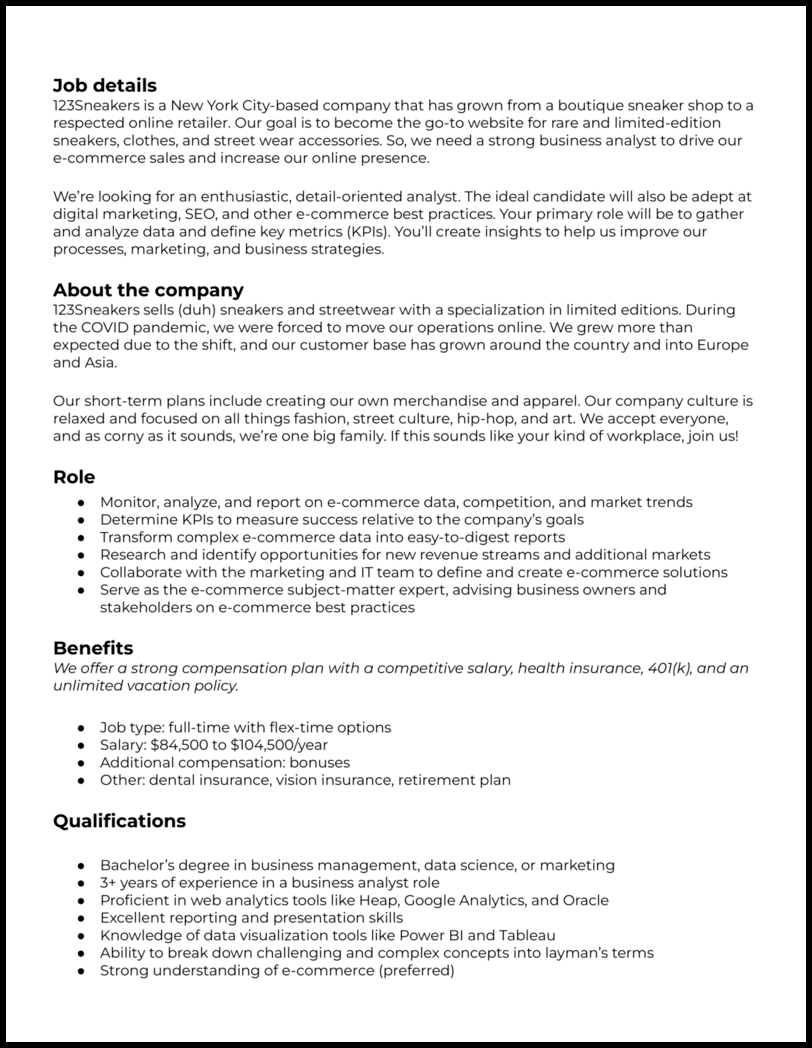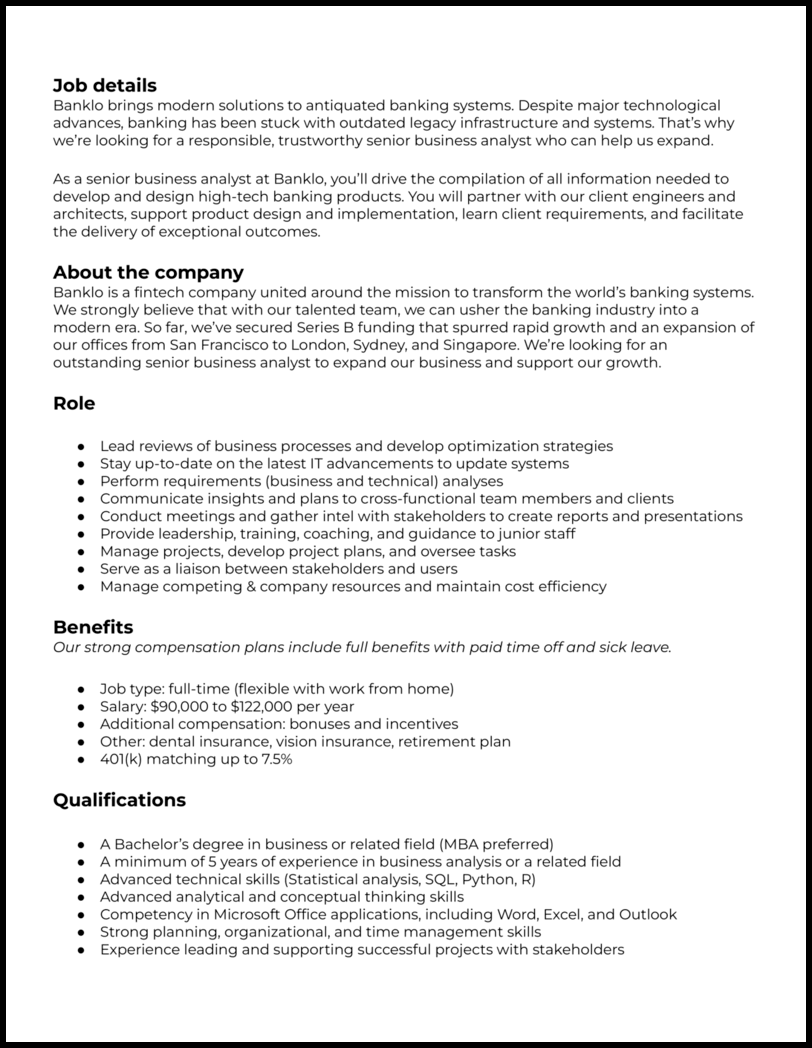A business analyst (BA) is a critical component of any big project. Since they’re the link between the end user and the project manager, they must have technical skills, strong communication abilities, and a detail-oriented and analytical mindset.
Since business analysts do just about everything, when it comes time to write your business analyst job description, it’s challenging to include all the skills your future hire needs to possess.
This guide has three examples and plenty of writing tips that can walk you through how to write an immersive business analyst job description. We’ll also explain all the critical aspects of the role, so you’ll know exactly what to look for when candidates submit their business analyst resumes and cover letters.
Why this job description works
- In your job requirements section, strike a balance between interpersonal and technical requirements to attract candidates with all the skills needed to succeed.
- Don’t include every single requirement you think they’ll handle. You don’t want to overwhelm candidates with too much information!
- In the qualifications section of your business analyst job description, list the necessary experience and degrees first.
- Spotlighting the essentials will enable applicants to decide if they want to apply. The further you go, the less important the requirement should be.
Why this job description works
- Never underestimate the power of clarity! Introduce your senior business analyst job description by launching right into the industry-wide impact of the job.
- Job seekers want to know what they’ll accomplish along with the necessary contextual details, especially notes about the industry.
- The responsibilities and qualifications sections for a senior role are bound to be long, but strive to keep each bullet point concise.
- Providing a straightforward and readable list of requirements will help desirable candidates pick the most relevant skills for their resumes.
Why this job description works
- People want a job that makes a difference. So, what values can you mention in your agile business analyst job description that make the position meaningful?
- That’s why it can help to reinforce your company’s vision and history. Just keep it brief to avoid overwhelming candidates.
- If you offer a great benefits package, then play it up! You gain nothing by hiding the perks (and the salary) associated with the job.
- Candidates want to know they’re valued, and a good benefits section assures them their skills will be compensated. Plus, a substantial benefits section indicates the job’s level, which means you attract more qualified candidates.
Writing Guide for a Business Analyst Job Description

Your job description is the first point of contact between you and your prospective employee. For this reason, you need to keep things tight, lean, and punchy while also being informative and honest.
It sounds difficult, but it’s achievable! Don’t take the easy out by editing a similar (lower-level) job description and modifying it. This is a surefire way to write a bloated and outdated job description.
Before you start writing, take a step back and think about why you’re hiring for this role in the first place. What are your business goals, and how will a BA help you achieve them? What challenges do you want them to tackle?
For example, do you want your business analyst to identify under-performing processes and determine solutions? Or do you need them to effectively communicate with stakeholders about proven strategies to implement?
Take a step back and think about why you’re hiring for this role in the first place.
Applicants want to know your motivations, so tell them straight out! Let them know what you require and expect regarding their expertise.
Once you’ve identified your motivations, get to writing! Include everything you can think of, then get to editing. Avoid listing generic requirements and responsibilities, and keep only the essentials.
While you may be tempted to keep every single requirement, remember that a lengthy job description turns away readers. Plus, it can hinder your efforts toward writing an inclusive job description.
When you’re certain you’ve included all the correct details (and excluded what’s unnecessary), put your job description away for a day or two. Send it off to a few colleagues, and encourage them to provide constructive criticism.
After you’ve gotten some feedback, make any necessary revisions and give it a final once-over for any typos or spelling errors. Then you’re ready to post your clear and concise job description and wait for the business analyst resumes to come flooding in.
Outlining Your Business Analyst Job Description

Staring at a blank document is always daunting, so use our outline below for inspiration. Just fill in the details, and you’ll have a first-rate business analyst job description before you know it.

Job details
This is basically an introduction to your company and the position. Briefly explain the purpose of the company and why you need a business analyst. Communicate to the reader what the position will entail. This section is a good place to share your company ethos and values, but keep it short.

About the company
You can talk about your mission, vision, and values, and even a bit of your history, so long as you keep it short. Finish strong and make the reader excited to work for your company. Show the heart of your organization and why it’s a great company to work for!

What you’ll be doing
This section can also be referred to as “Roles,” “Responsibilities,” or “Requirements,” but either way, it’s where you list the activities and tasks that go into the role. Many applicants will skip straight to this section.
Most of all, don’t overwhelm your reader. Yes, business analysts perform many roles, but don’t add everything. You should definitely include any distinct practices that are unique to your company, but don’t go overboard.
To ensure that your writing is clear and concise, use active verbs to start every bullet point and avoid overusing jargon, acronyms, and industry terms.
- Evaluate business processes, anticipate requirements, uncover areas for improvement, and develop and implement solutions
- Lead reviews of business processes and develop optimization strategies
- Stay up-to-date on the latest IT advancements to automate and modernize systems
- Perform requirements (business and technical) analyses
- Conduct meetings and gather critical information with various stakeholders to produce useful reports and presentations

Qualifications
This section is vital to ensure you get capable applicants. You should list the proper credentials, experience, and skills required to do the job.
You should include everything that’s necessary, of course, but you can also include (some) “nice to have” criteria. If you have other qualifications you’d like, you can add a few and specify that they’re optional.
- Bachelor’s degree in business management, data science, or marketing
- 3+ years of experience in a business analyst role
- Proficient in web analytics tools like Heap, Google Analytics, and Oracle
- Deep knowledge of e-commerce (preferred)
- Excellent reporting and presentation skills
- Knowledge of data visualization tools like Power BI and Tableau

Salary and benefits
The benefits section is generally just a simple list of the compensation and rewards you get working for a company. Again, make it easy to digest, but be comprehensive. Include health insurance, dental plans, child care, flex-scheduling, 401(k), and anything else that you offer.
The Many Functions of a Business Analyst

Business analysts typically fulfill lots of different functions. Each company and industry sector has its own needs and requirements.
Below are some sample roles a business analyst might perform as part of their job. They may not serve in all of these roles, but they are all common responsibilities that will give you some inspiration.

Functional analysis
Companies will bring in a BA quite frequently for the sole purpose of assessing business processes. This is a standard and mission-critical job role for a BA, so these responsibilities are great to add to your job description.
- Interview stakeholders and process owners to evaluate current state processes
- Perform gap analysis and suggest enhancements and/or new processes
- Assist with the design of new processes and improvements
- Conduct business process modeling and generate scenarios for testing
- Provide support, documentation, and assistance for business process owners

Data analysis
A business analyst needs to be an expert at studying data, identifying patterns, and making strategic data-based recommendations. This is a highly technical skill, yet it’s key for a BA.
- Perform data collection, consolidation, and summation
- Define requirements for the creation of data sets and data warehouses
- Determine reliable metrics and KPIs
- Develop reporting based on business needs
- Make recommendations for improvements on data collection, processing, and reporting

Business requirements
Business analysts often partner with the business and business process owners to determine and document the business needs. This includes converting them into tangible and actionable business and technical requirements for new or enhanced business processes.
- Analyze business needs and develop KPIs to ensure initiatives and projects meet business requirements
- Convert business requirements into workable process designs and workflows
- Collaborate with project managers and teams to ensure that all business requirements are accurately converted into technical requirements
- Perform and/or facilitate systems, integration, and end-to-end testing for new and enhanced processes

IT systems
IT is ubiquitous in the world, and most business analysts are required to be very knowledgeable, if not an expert, on IT-related areas and functions. This is an important function for just about any BA, even if they are working for a non-IT business unit.
- Assess business functionality and user interfaces
- Help define systems interfaces, data transfers, and integrations
- Facilitate user acceptance testing of software implementations and changes
- Analyze current software, and suggest new features to improve efficiency

Reporting
A business analyst is also quite often used as a resource for business reporting. Similar to IT-related skills, your BA should be very strong with understanding, evaluating, and creating reports that the business can use.
- Assess current business reporting, identifying strengths, weaknesses, and opportunities
- Make recommendations for improvements on data used, formatting, delivery, storage, and ongoing management of reports
- Facilitate design, formatting, and documentation for new and enhanced reports
- Collaborate with report developers and IT staff to define and document technical requirements for reports








